Papers by Oliemen Peterside

The Nigerian Health Journal, 2014
Background Hepatitis B virus (HBV) infection causes significant morbidity and mortality worldwide... more Background Hepatitis B virus (HBV) infection causes significant morbidity and mortality worldwide. Occupational exposure of health care workers and medical students increases their risk of acquiring HBV infection, and many authorities recommend vaccination. However, significant proportions of health care workers do not receive HBV immunization, and remain at increased risk to HBV infection. The objective of this study was to determine the hepatitis B vaccination rate among Medical students at the University of Port Harcourt Teaching Hospital (UPTH) and to determine their knowledge of HBV infection. Methods Three hundred and sixteen medical students at UPTH completed Selfadministered questionnaires which included questions about demographic characteristics, HBV vaccination status, knowledge of hepatitis B vaccine and reasons for not receiving the vaccine. Results All (100%) of the respondents had heard of hepatitis B vaccine. 7Wo hundred and twenty two (70.2%) of them thought they...

Diabetes mellitus (DM) is the most common endocrine disorder of childhood and adolescence. Urine ... more Diabetes mellitus (DM) is the most common endocrine disorder of childhood and adolescence. Urine testing for glycosuria is an important screening to ol for DM, especially in mass screening programmes. The screening of secondary school children in Port Harcourt for DM was done using glycosuria as a screening tool. Also, the relationship between risk factors for DM and glycosuria was determined. In November 2008, a cross sectional study of 1008 stud ents aged 10 to 18 years from 12 secondary schools in Port Harcourt was carried out. Structure d questionnaires were completed by the investigators. Urine glucose was determined using a dipstick urinary multistix strip.The prevalence of glycosuria was 0.7% with males having a higher prev alence (1.2%) than females (0.2%). Glycosuria was found more amongst children aged 16 to 17 years (1. 1%), children from private schools (0.9%) and children in social class IV (3.3%). The relationshi p between elevated blood pressure and glycosuria wa s st...
Congenital diaphragmatic hernia is uncommon with an incidence of 1 in 2000 to 3500 live births. L... more Congenital diaphragmatic hernia is uncommon with an incidence of 1 in 2000 to 3500 live births. Less than 20% of cases present outside the neonatal period frequently posing diagnostic challenges. We report a case of congenital diaphragmatic hernia in a three-year-old boy who had previously been treated at other centres without a definitive diagnosis. This is aimed at highlighting the diagnostic and treatment challenges involved in the management of this patient.

The Internet Journal of Pediatrics and Neonatology, 2012
: Neonatal tetanus (NNT) though preventable, remains a significant cause of morbidity and mortali... more : Neonatal tetanus (NNT) though preventable, remains a significant cause of morbidity and mortality in developing countries like Nigeria.Objective: A study was carried out in the Paediatrics unit of the Niger Delta University Teaching Hospital (NDUTH), Bayelsa State, Nigeria to highlight the burden of NNT in the state and proffer solutions which may be useful in its eradication.Methodology: Over a 5 year period (from May 2007 to April 2012), all cases of NNT admitted into the Paediatrics unit of the NDUTH were retrospectively studied.Results: A total of 4780 children were admitted during the study period. Neonatal tetanus accounted for 40 (0.84%) of these admissions, with a male to female ratio of 1:2, and a mean age of 8.3 days. Thirty four (77.3%) of the mothers had no antenatal care and delivered outside health facilities. Razor blade was used to cut the umbilical cord in 37.5% of the cases and hair thread was used to tie the cord in 15.0%. Seventeen (42.5%) of the mothers had no formal education. Fifteen of the 40 patients died, giving a case fatality rate of 37.5%. The case fatality rate for males (46.2%) was higher than that for females (33.3%). NNT accounted for 3.5% of all Paediatric deaths and 9.0% of neonatal deaths. Conclusion: NNT is still a significant cause of morbidity and mortality in this environment. Efforts aimed at eradication of this social scourge should be intensified and more efforts should be geared towards improving the anti-tetanus vaccine coverage rate of all women even before they get to child bearing age.
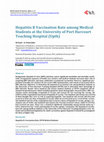
World Journal of Vaccines, 2015
Background: Hepatitis B virus (HBV) infection causes significant morbidity and mortality worldwid... more Background: Hepatitis B virus (HBV) infection causes significant morbidity and mortality worldwide. Occupational exposure of health care workers and medical students increases their risk of acquiring HBV infection, and many authorities recommend vaccination. However, significant proportions of health care workers do not receive HBV immunization, and remain at increased risk to HBV infection. Objective: To determine the hepatitis B vaccination rate among Medical students at the University of Port Harcourt Teaching Hospital (UPTH) and to determine their knowledge of HBV infection. Result: Three hundred and sixteen medical students at UPTH completed self-administered questionnaires which included questions about demographic characteristics, HBV vaccination status, knowledge of hepatitis B vaccine and reasons for not receiving the vaccine. All (100%) of the respondents had heard of hepatitis B vaccine. Two hundred and twenty two (70.2%) of them thought they were at risk of acquiring hepatitis. Two hundred and seventy (85.4%) had received at least one dose of hepatitis B vaccine while 46 (14.6%) had never received the vaccine. One hundred and ten of the respondents had received 3 doses of hepatitis B vaccine, giving a vaccination rate of 34.8%. One hundred and sixteen (36.7%) had received 2 doses, while 44 (13.9%) had received one dose. There was a statistical significant relationship among marital status (p = 0.01), clinical level (p = 0.02) and hepatitis B vaccine uptake. Conclusion: The hepatitis B vaccination rate among medical students at the University of Port Harcourt Teaching Hospital is low. National and institutional legislation for adult vaccination against Hepatitis B should be promulgated for those at higher risk.
British Journal of Medicine and Medical Research, 2014

Italian Journal of Pediatrics, 2012
BackgroundAdolescent weight status is a cumulative effect of health and nutritional problems. Ado... more BackgroundAdolescent weight status is a cumulative effect of health and nutritional problems. Adolescent weight problems often go unnoticed as weight assessment is not considered a priority in adolescents.ObjectivesTo determine the weight status of adolescents using BMI and to identify the contributing factors to adolescent weight problems.MethodsIn April 2010, 960 adolescents aged 10–19 years in secondary schools in Port Harcourt were selected for the study using a stratified multi-staged sampling method. Structured questionnaires were filled by the investigators while weight and height were measured. BMI was calculated using the formula weight/height2(kg/m2).ResultsThe prevalence of underweight, overweight, obesity and stunting were 6.4%, 6.3%, 1.8% and 5.4% respectively. Factors which were commoner in overweight adolescents were high socioeconomic class, higher maternal education, spending > 3 hours a day watching television and frequent ingestion of snacks.ConclusionThere is ...
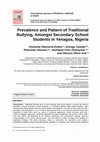
International Journal of TROPICAL DISEASE & Health
Introduction: Traditional bullying (face to face bullying, that occurs within or around the schoo... more Introduction: Traditional bullying (face to face bullying, that occurs within or around the school premises) among secondary school students is a persistent global public health problem; with varying long lasting mental, physical and academic consequences, not only on the victims but also the bullies and bystanders. It is a common phenomenon that is not limited to physical harm and manifests in many forms such as, verbal, or relational aggression, social exclusion and cyber victims of bullying. Bullying is commonly embedded in power imbalances and can be a call for help from the bullies. Development of an efficient prevention and intervention strategy requires understanding of the causes (family issues, low self esteem or lack of positive role models) of traditional bullying. This study therefore, aimed to determine the prevalence and pattern oftraditional bullying among secondaryschool students in Yenagoa Local Government, Bayelsa State Nigeria, which would aid development and impl...
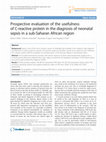
Antimicrobial Resistance and Infection Control, Jun 1, 2012
Background: Sepsis is one of the most common causes of morbidity and mortality in the newborn. Ea... more Background: Sepsis is one of the most common causes of morbidity and mortality in the newborn. Early diagnosis and treatment is vital to improve outcome. The present study was therefore carried out to determine the usefulness of C-reactive protein (CRP) for evaluation of neonatal sepsis in Port Harcourt, Nigeria in Sub-Saharan Africa. Method: Four hundred and twenty neonates with clinical suspicion of sepsis were prospectively studied over a 6 month period. Blood was obtained from each subject recruited for the qualitative estimation of CRP. Blood culture was used as gold standard for diagnosis of NNS. Results: Of 420 neonates studied, 196 (46.7%) had positive CRP while 181 (43.1%) had positive blood culture. The sensitivity, specificity, positive and negative predictive values of CRP were 74.0%, 74.1%, 68.4% and 79.0% respectively. Conclusion: The qualitative method of estimating CRP which is cheap and rapid has moderate sensitivity, specificity and negative predictive value.
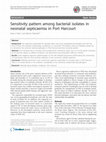
Annals of Clinical Microbiology and Antimicrobials, 2012
Background: The organisms responsible for neonatal sepsis vary across geographical boundaries and... more Background: The organisms responsible for neonatal sepsis vary across geographical boundaries and with the time of illness thus periodic bacteriologic surveillance is a neccessity. The present study was therefore carried out to determine the common bacterial pathogens in Port Harcourt and their sensitivity pattern. Methods: Four hundred and six neonates were prospectively screened for sepsis over a 6 month period. Sensitivity of the bacterial isolates to different antibiotics was determined using Kirby-Bauer diffusion method. Results: Gram negative organisms predominated (75.1%) with Klebsiella pneumonia (58.2%) being the commonest. The quinolones were the most sensitive antibiotics to the commonly isolated organisms. Conclusion: Klebsiella pneumonia is the commonest organism responsible for neonatal sepsis in Port Harcourt. There is an overall decline in the antibiotic susceptibility to the commonly isolated bacterial pathogens.
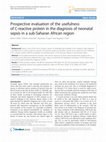
Antimicrobial Resistance and Infection Control, 2012
BackgroundSepsis is one of the most common causes of morbidity and mortality in the newborn. Earl... more BackgroundSepsis is one of the most common causes of morbidity and mortality in the newborn. Early diagnosis and treatment is vital to improve outcome. The present study was therefore carried out to determine the usefulness of C-reactive protein (CRP) for evaluation of neonatal sepsis in Port Harcourt, Nigeria in Sub-Saharan Africa.MethodFour hundred and twenty neonates with clinical suspicion of sepsis were prospectively studied over a 6 month period. Blood was obtained from each subject recruited for the qualitative estimation of CRP. Blood culture was used as gold standard for diagnosis of NNS.ResultsOf 420 neonates studied, 196 (46.7%) had positive CRP while 181 (43.1%) had positive blood culture. The sensitivity, specificity, positive and negative predictive values of CRP were 74.0%, 74.1%, 68.4% and 79.0% respectively.ConclusionThe qualitative method of estimating CRP which is cheap and rapid has moderate sensitivity, specificity and negative predictive value.
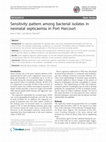
Annals of Clinical Microbiology and Antimicrobials, 2012
Background: The organisms responsible for neonatal sepsis vary across geographical boundaries and... more Background: The organisms responsible for neonatal sepsis vary across geographical boundaries and with the time of illness thus periodic bacteriologic surveillance is a neccessity. The present study was therefore carried out to determine the common bacterial pathogens in Port Harcourt and their sensitivity pattern. Methods: Four hundred and six neonates were prospectively screened for sepsis over a 6 month period. Sensitivity of the bacterial isolates to different antibiotics was determined using Kirby-Bauer diffusion method. Results: Gram negative organisms predominated (75.1%) with Klebsiella pneumonia (58.2%) being the commonest. The quinolones were the most sensitive antibiotics to the commonly isolated organisms. Conclusion: Klebsiella pneumonia is the commonest organism responsible for neonatal sepsis in Port Harcourt. There is an overall decline in the antibiotic susceptibility to the commonly isolated bacterial pathogens.

International journal of contemporary pediatrics, May 27, 2024
Background: Previous studies have shown that when standing height is difficult to measure, the le... more Background: Previous studies have shown that when standing height is difficult to measure, the length of other body parts may be a reliable alternative. However, there is limited information about the use of foot length (FL) and foot breadth (FB) in estimating standing height in the African population. The objective of this study was to investigate the appropriateness of foot length and foot breadth in estimating standing height of adolescents in Yenagoa. Methods: Using a multistage sampling technique, 1222 adolescents were recruited from secondary schools in the Yenagoa local government area. Height, foot length, and foot breadth were measured using standard techniques. Data was analysed and equations for prediction of standing height from foot length and foot breadth, were derived. Results: The mean standing height of the females was significantly lower than that of males (p<0.001). The mean foot length and mean foot breath for males were significantly higher than those for females. The mean foot length and mean foot breadth were found to increase across all the stages of adolescence. There was a significant positive correlation between standing height and foot length (r=0.700; p<0.001), foot breadth (r=0.543; p<0.001), and age (r=0.369; p<0.001). Multiple linear regression was used to derive equations for the estimation of FL and FB. Conclusions: This study found that FL and FB can be used in the estimation of standing height. For adolescents in Yenagoa, the equations derived are recommended for predicting the standing height of those who have difficulty standing upright.
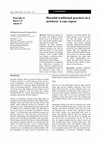
Nigerian Journal of Paediatrics
Ninetynine percent of the nearly four million newborn deaths occur in developing countries with n... more Ninetynine percent of the nearly four million newborn deaths occur in developing countries with newborn deaths remaining relatively invisible and neglected1. In these countries, traditional attitudes and practices dominate newborn care and are often harzadous2. As most births and newborn deaths in developing countries occur outside health care facilities, a reduction in neonatal mortality may depend significantly on interventions involving adaptation of traditional care behaviours practiced at home3. However, despite the importance of traditional practices in the newborn period, little is known about the impact of these practices on newborn health2. We herein present a case of an eighteen day old female who was rushed to the hospital with severe wasting, recto-vaginal prolapse and septic umbilical cord resulting from repeated traditional homecare practices by her mother and grandmother. This case highlights the impact of harmful traditional home care practices on newborn health and ...
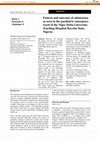
Objective: To describe the pattern and outcome of childhood illnesses seen in a paediatric emerge... more Objective: To describe the pattern and outcome of childhood illnesses seen in a paediatric emergency ward of a tertiary centre in the Niger Delta region of Nigeria.Methods: Admission records of all children seen in the Children’s Emergency Ward (CHEW) between the 1st of January 2008 and 31st ofDecember 2011 were retrospectively reviewed and analysed.Results: A total of 1756 children were admitted into the emergency ward over a four year period (1st January 2008 to 31st December 2011). The age range was one month to 18 years with a mean of 36.6 months. There was a male preponderance with a male to female ratio of 1.4:1. Majority, 1386 (78.9%) of the patients were below the age of five years. The meanduration of stay was 2.2 days. The major causes of admission were malaria, 562 (32.0%), diarrhoeal disease 389 (22.2%), respiratory tract infections 162 (9.2%) and anaemic heart failure 112(6.4%). Peak admissions period and mortality were in the months of January, May and December. There ...
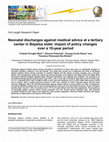
Discharge against medical advice among neonates is worrisome as there have been no substantial ch... more Discharge against medical advice among neonates is worrisome as there have been no substantial changes in neonatal mortality in Nigeria in the last decade. This study was carried out to determine the trend of discharge against medical advice among neonates in southern Nigeria and the impact of policy changes over a ten-year period. This retrospective study was carried out among neonates at the Special Care Baby Unit of the Niger Delta University Teaching Hospital, Bayelsa State. Relevant information was obtained and analyzed. The prevalence of neonatal discharge against medical advice was 3.97%, with a mean age of 4.81±5.33 days and a male to female ratio of 1.4:1. It declined from 1.82% in 2009 to 0.85% in 2011 and rose sharply to 9.37% in 2013. A50% fees waiver in 2015 had no impact, while a health insurance scheme in 2017 saw a decline to 3.52%. Neonatal sepsis was the most common diagnosis. Most [43 (56.2%)] discharges against medical advice occurred within six days of admission. Forty-three (58.90%) parents were in the low socioeconomic class and none had health insurance. A lack of finance was the major reason in 74% of neonates and in 76.7% of cases fathers were the main signatories. The prevalence of discharge against medical advice among neonates over the 10-year period remained high, with financial constraint being the main reason and sepsis the most common diagnosis. Universal health insurance will impact positively on itsprevalence and improve child health.

Abstract: Background: Sepsis is one of the most common causes of neonatal hospital admissions an... more Abstract: Background: Sepsis is one of the most common causes of neonatal hospital admissions and is estimated to cause 26 % of all neonatal deaths worldwide. While waiting for results of blood culture, it is necessary to initiate an empirical choice of antibiotics based on the epidemiology of causative agents and antibiotic sensitivity pattern in a locality. Objective: To determine the major causative organisms of neonatal sepsis at the Niger Delta University Teaching Hospital (NDUTH), as well as their antibiotic sensitivity patterns, with the aim of formulating treatment protocols for neonates. Methods: Within a 27-month period (1st of October 2011 to the 31st of December 2013), results of blood culture for all neonates screened for sepsis at the Special Care Baby Unit of the hospital were retrospectively studied. Results: Two hundred and thirty-three (49.6%) of the 450 neonates admitted were screened for sepsis. Ninety-seven (43.5%) of them were blood culture positive, with 52 (...

Measles control is yet to be achieved in Nigeria de spite global efforts geared towards measles e... more Measles control is yet to be achieved in Nigeria de spite global efforts geared towards measles elimination. The aim of this study was to determine the prevalence and describe the pattern of childhood measles among children presenting to the Niger Delta University Teaching Hospital (NDUTH), Okolobri, Bayelsa State. Case notes of chi ldren with measles seen at the NDUTH over a five year period (1 st September 2008 to 31 st August 2013) were retrospectively reviewed. A hund red and seventeen (117) cases of measles were seen at t he NDUTH. Measles constituted 2.0% of the total paediatric admissions and the peak age of pre sentation was in infancy (41.0%). Twenty-seven (23.1%) of the children were less than 9 months old . Majority (81.2%) had not received prior measles vaccine with a major reason given for failure to re ceive the vaccine being that the child was not up to the age for immunization. Complications occurred more in the malnourished and the un- vaccinated children. Of the 76...
British Journal of Medicine and Medical Research, 2017
Background: Ear infections are common in childhood. The diagnosis and management of these infecti... more Background: Ear infections are common in childhood. The diagnosis and management of these infections in children is often difficult due to absence or non-implementation of clinical guidelines in developing countries like Nigeria. Empiric treatment is very common. Methods: In order to determine the microbial agents responsible for ear infections in the paediatric population, the records of children sent for ear infection investigations over a twenty-eight month period were analysed. Results: Positive cultures were obtained from 60.8% of the patients. The incidence was greatest in the zero to twelve months and one year to three years age groups. There was a male preponderance of subjects with ear infections. Only 47 (23.6%) of the subjects had full ear Original Research Article

Uploads
Papers by Oliemen Peterside